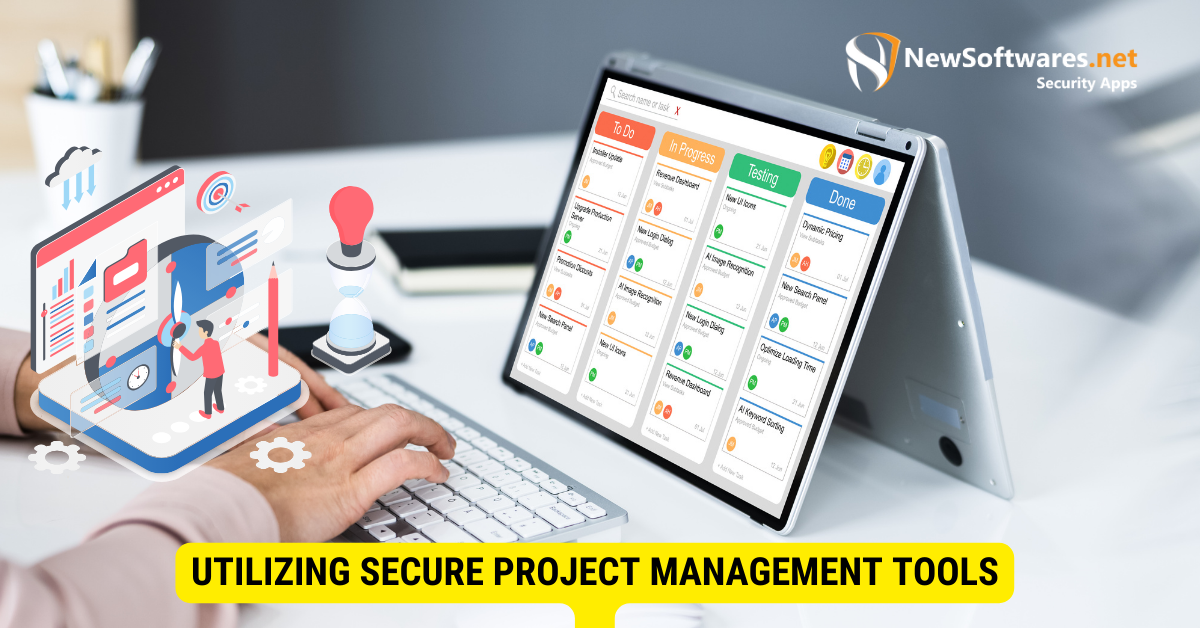You can ensure the security of project data by implementing robust encryption, controlling access, updating software, conducting regular audits, and educating team members.
Project data security is integral to project management, especially in today’s digital age. Mismanagement of project data could result in confidential information falling into the wrong hands, ultimately leading to potential loss of client trust and business reputation. We will delve into the necessary steps to ensure the security of your project data.
Understanding the Importance of Project Data Security

In any project, data plays a critical role. Understanding its importance is the first step in ensuring data security. Data is the backbone of these essential aspects, from project management to decision-making and forecasting.
Data security goes beyond just protecting sensitive information. It encompasses safeguarding project data’s accuracy, integrity, and availability throughout its lifecycle. By implementing robust security measures, organizations can mitigate risks and ensure the smooth operation of their projects.
The Role of Data in Project Management
Effective project management significantly relies upon the accurate and reliable collection and interpretation of data. Data helps project managers in risk forecasting, resource allocation, and measuring project success. Hence, the security of such data is of prime importance.
Project managers rely heavily on data to make informed decisions. Whether analyzing historical project data to identify potential risks or using real-time data to track progress, data is the foundation for effective project management.
Furthermore, project data provides valuable insights that enable managers to optimize resource allocation. By analyzing resource utilization and performance data, project managers can identify areas for improvement, allocate resources efficiently, and enhance project outcomes.
Without proper data security, the accuracy and reliability of the data can be compromised, impacting the project’s success. In addition, the organization can face legal consequences, especially when dealing with sensitive client data.
Risks Associated with Insecure Data
The risks of insecure project data are wide-ranging. These are just a few potential risks, from financial losses due to fraud and theft to reputational damage from data breaches. For instance, it could also disrupt project workflow if the data becomes inaccessible due to a ransomware attack.
Financial losses resulting from data breaches can be substantial. Organizations may suffer financial fraud, where unauthorized individuals access and exploit sensitive financial data for personal gain. Additionally, theft of intellectual property or trade secrets can lead to significant financial setbacks and loss of competitive advantage.
Moreover, damage control in the aftermath of a data breach can be expensive. Organizations may have to pay heavy fines for non-compliance with data protection regulations, not to mention the costs associated with system recovery and fortification.
Reputational damage is another significant risk associated with insecure project data. When customer data is compromised, organizations may face public scrutiny and loss of trust. This can result in a decline in customer loyalty, negative brand perception, and, ultimately, a loss of business opportunities.
Furthermore, the impact of data breaches extends beyond the organization itself. It can affect stakeholders such as clients, partners, and employees who entrust their data to the organization. The breach of their personal information can lead to identity theft, financial fraud, and other detrimental consequences.
Organizations must prioritize data security to protect their projects, stakeholders, and reputation. By implementing robust security measures, organizations can minimize the risks associated with insecure project data and ensure their valuable information’s confidentiality, integrity, and availability.
Establishing a Robust Data Security Policy
Establishing a robust data security policy is crucial to ensuring project data security. In today’s digital age, where data breaches and cyberattacks are becoming increasingly common, organizations must proactively protect their sensitive information. By implementing a comprehensive data security policy, businesses can safeguard their data from potential threats and mitigate the risks associated with unauthorized access or data loss.
When creating a data security policy, it is essential to consider various factors that can impact the organization’s data security. Firstly, the policy should clearly define what needs to be protected. This includes not only the personal information of customers and employees but also intellectual property, trade secrets, financial records, and any other sensitive data critical to the organization’s operations.
Identifying potential threats is another crucial aspect of a robust data security policy. Organizations need to conduct a thorough risk assessment to understand their data infrastructure’s potential vulnerabilities and weaknesses. This can include external threats like hackers, malware, phishing attacks and internal threats like employee negligence or malicious intent.
Once the data types and potential threats have been identified, the policy should outline the measures for protection. This can include a range of security controls, such as strong passwords, encryption, access controls, regular data backups, and firewalls. These security measures can significantly reduce the risk of unauthorized access or data breaches.
Key Elements of a Data Security Policy
A good data security policy focuses on several areas to ensure comprehensive protection. Firstly, it identifies the various data types and assets that need protection. This includes personally identifiable information (PII) such as names, addresses, social security numbers, and credit card information. It also encompasses proprietary information, trade secrets, and confidential data critical to the organization’s success.
Secondly, a robust data security policy defines data management and protection responsibilities and roles. This includes designating individuals or teams responsible for data security, enforcing access controls, and ensuring compliance with relevant regulations such as the General Data Protection Regulation (GDPR) or the Health Insurance Portability and Accountability Act (HIPAA).
Furthermore, the policy outlines the security controls, from passwords and encryption to backups and firewalls. It establishes guidelines for creating strong passwords, encrypting sensitive data at rest and in transit, regularly backing up data to prevent loss, and implementing firewalls to protect against unauthorized access.
A strong data security policy also addresses the responses to potential security incidents. It details processes for reporting breaches, conducting investigations, and taking corrective actions. A well-defined incident response plan can minimize the impact of a security incident and ensure a swift and effective response to mitigate any potential damage.
Moreover, the policy provides guidelines for training and awareness creation among personnel. Regular training sessions and awareness programs can educate employees about data security, common threats, and best practices for protecting sensitive information. By fostering a culture of security awareness, organizations can significantly reduce the risk of human error or negligence leading to data breaches.
Implementing and Enforcing Your Policy
A data security policy is only as good as its implementation. Ensuring that the policy is enforceable and consistently applied throughout the organization is essential. This can be achieved through regular audits and staff training sessions to assess compliance and identify areas for improvement.
Furthermore, including data security responsibilities in job descriptions can ensure accountability and clarify that data security is a shared responsibility across the organization. By integrating data security into the core job functions, employees are more likely to prioritize and adhere to the policy.
Effective enforcement also involves maintaining an open dialogue about data security. Regular updates to staff about potential threats, emerging trends, and best practices can enhance compliance with the security policy. This can be done through internal communications channels like newsletters, emails, or dedicated intranet portals.
In conclusion, establishing a robust data security policy is vital for organizations to protect their sensitive information from potential threats. Businesses can enhance their data security posture by identifying the data types that need protection, understanding potential risks, and implementing appropriate security measures. Furthermore, organizations can ensure that the policy is effectively implemented and enforced by defining responsibilities, addressing incident response, and promoting employee awareness. Data security is an ongoing process, and organizations must continuously monitor and update their policies to stay ahead of evolving threats in the digital landscape.
Utilizing Secure Project Management Tools

Opting for secure project management tools is another significant step toward data security. These tools should offer strong security features while also aiding efficient project management.
Features to Look for in Secure Tools
Secure project management tools should offer role-based access control, data encryption, and robust password policies. Additionally, they should provide audit logs and breach notification capabilities. Remember, a secure tool should always support regulatory compliance requirements.
Consider the integration capabilities of the tool as well. It’s helpful if the tool can integrate with other systems seamlessly, allowing for unified data management. Over time, this can greatly simplify the data protection process.
Top Secure Project Management Tools
Several established and reliable project management tools are in the market today, emphasizing data security. These include Asana, Trello, and Zoho, among others. These tools are known for their strong security features and robust project management capabilities.
However, the choice of tool should heavily depend on your organization’s specific needs and budget. Always conduct diligent research and take advantage of trial periods before selecting a tool.
Training Your Team on Data Security
Training is a crucial part of data security. All members of your team must understand the importance of protecting data and be fluent in the best practices for doing so.
Importance of Regular Training Sessions

Training sessions should be held regularly to ensure all team members are on the same page regarding data security. These sessions should stress the importance of protecting sensitive information and offer practical instruction on how to do so.
Then, regular tests and quizzes can be beneficial to reinforce learning and evaluate comprehension. These sessions can also offer a platform for staff to raise any security concerns and suggestions.
Best Practices for Data Security Training
Data security training should be engaging and practical. It should include real-life scenarios, and role play to help staff understand the potential risks and appropriate responses. It should also cover the company’s data security policy and the staff’s role in upholding it.
Moreover, every training session should be an opportunity to assess and improve your data security policy and practices, allowing for a continuously improving data protection plan.
Regular Auditing and Updating Security Measures
Even with a robust data security policy and training program, constant vigilance is required to ensure ongoing security. Regular audits should be conducted, and security measures should be constantly updated to keep up with evolving cyber threats.
How to Conduct a Data Security Audit
A data security audit involves checking the current data security measures to identify any weak points. It entails reviewing access controls, security policy compliance, and incident response plans.
An audit can be conducted internally, but an external auditor might bring new perspectives. Regardless of who conducts the audit, the findings should be discussed and acted upon to strengthen security measures.
Keeping Your Security Measures Up-to-Date
Finally, remember that data security is an ongoing process. As new threats emerge and technologies evolve, it is essential to update your security measures continuously. This might involve shifting to newer, more secure technologies or updating current ones.
Additionally, it is crucial not to overlook staff training in this process. Constant updates on changing policies and emerging threats can keep everyone vigilant and proactive in securing your project data.
Key Takeaways
- Use strong encryption methods to protect data.
- Limit and monitor access to only necessary personnel.
- Keep all software and security patches up to date.
- Conduct regular security audits to detect vulnerabilities.
- Educate team members about security best practices.
FAQs
Q: What’s the first step to securing project data?
A: Implementing robust encryption methods.
Q: How do I limit data access?
A: Use access control methods and assign permissions only to necessary team members.
Q: Why are security audits important?
A: They help identify and rectify potential vulnerabilities in the system.
Q: How often should I update software for security?
A: Regularly install security patches as soon as they’re available.
Q: How can team members help in ensuring data security?
A: By being educated about and following security best practices.
Conclusion
To conclude, project data security is something that cannot be overlooked. By understanding its importance, drafting an inclusive policy, utilizing secure project management tools, and conducting regular audits, you can significantly enhance the security of your project data.
